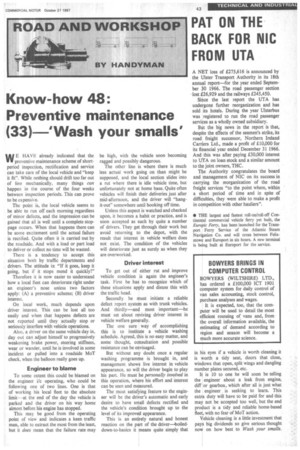Know-how 48: Preventive maintenance (33) 'Wash your smalls'
Page 45

If you've noticed an error in this article please click here to report it so we can fix it.
WE HAVE already indicated that the preventive maintenance scheme of shortperiod inspection, rectification and service can take care of the local vehicle and "keep it fit". While nothing should drift too far out of line mechanically, many things can happen in the course of the four weeks between inspection periods. This can prove to be expensive.
The point is, the local vehicle seems to be able to run off each morning regardless of minor defects, and the impression can be gained that all is well until a complete stoppage occurs. When that happens there can be some excitement until the actual failure is rectified. Quite often it is carried out by the roadside. And with a load or part load to deliver or collect no time will be wasted.
There is a tendency to accept this situation both by traffic departments and drivers. The attitude is: "If it goes, keep it going, but if it stops mend it quickly!"
Therefore it is now easier to understand how a local fleet can deteriorate right under an engineer's nose unless two factors apply: (A) a preventive scheme; (B) driver interest.
On local work, much depends upon driver interest. This can be lost all too easily and when that happens defects are not reported until they actually stop or seriously interfere with vehicle operations.
Also, a driver on the same vehicle day in, day out can adjust himself to progressively weakening brake power, steering stiffness, wear or wander, until he is involved in some incident or pulled into a roadside MoT check, when the balloon really goes up.
Engineer to blame
To some extent this could be blamed on the engineer i/c operating, who could be following one of two lines. One is that of working his local fleet to the absolute limit at the end of the day the vehicle is parked and the driver on his way home almost before his engine has stopped.
This may be good from the operating point of view and indicates a keen traffic man, able to extract the most from the least, but it does mean that the failure rate may
be high, with the vehicle soon becoming ragged and possibly dangerous.
The other line is where there is much less actual work going on than might be supposed, and the local section slides into a rut where there is idle vehicle time, but unfortunately not at home base. Quite often vehicles will finish their deliveries just after mid-afternoon, and the driver will "hangit-out" somewhere until booking off time.
Unless this aspect is watched and checked upon, it becomes a habit or practice, and is soon accepted as such by quite a number of drivers. They get through their work but avoid returning to the depot, with the result that interest in vehicle welfare does not exist. The condition of the vehicles will deteriorate just as surely as when they are overworked.
Driver interest To get out of either rut and improve vehicle condition is again the engineer's task. First he has to recognize which of these situations apply and disuss this with the traffic head.
Secondly he must initiate a reliable defect report system as with trunk vehicles. And thirdly—and most important—he must set about reviving driver interest in vehicle welfare generally.
The one sure way of accomplishing this is to institute a vehicle washing schedule. Agreed, this is no easy matter, and some thought, consultation and possible resistance can be envisaged.
But without any doubt once a regular washing programme is brought in, and management shows live interest in vehicle appearance, so will the driver begin to play his part. He must be personally involved in this operation, where his effort and interest can be seen and measured.
The most satisfying feature to the engineer will be the driver's automatic and early desire to have small defects rectified and the vehicle's condition brought up to the level of its improved appearance.
This is an entirely natural and honest reaction on the part of the driver—boileddown-to-basics it means quite simply that






















































































































